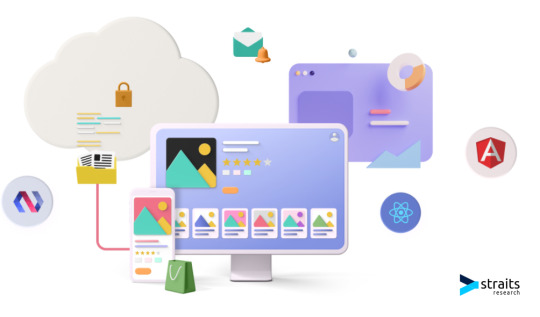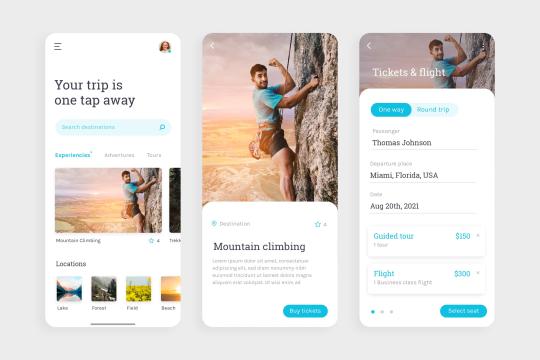#progressivewebapps
Explore tagged Tumblr posts
Text

Progressive Web App Development: A Modern Solution for Better User Experience
Progressive Web App Development (PWA) combines the best of web and mobile apps, offering enhanced user experiences. Here’s why PWAs are gaining popularity:
Faster Load Times: Instantly loads with minimal data usage.
Offline Capabilities: Works even without an internet connection.
Push Notifications: Engages users with timely updates.
PWAs provide an efficient, cost-effective alternative to traditional mobile app development. Choose PWA for a seamless experience! Stigasoft is one of the best providers of Progressive Web App Development for businesses looking to stay ahead.
0 notes
Text

The Rise of PWAs: Revolutionizing Mobile and Web Experiences
The Progressive Web Apps Market Report provides essential insights for business strategists, offering a comprehensive overview of industry trends and growth projections. It includes detailed historical and future data on costs, revenues, supply, and demand, where applicable. The report features an in-depth analysis of the value chain and distributor networks.
Employing various analytical techniques such as SWOT analysis, Porter’s Five Forces analysis, and feasibility studies, the report offers a thorough understanding of competitive dynamics, the risk of substitutes and new entrants, and identifies strengths, challenges, and business opportunities. This detailed assessment covers current patterns, driving factors, limitations, emerging developments, and high-growth areas, aiding stakeholders in making informed strategic decisions based on both current and future market trends. Additionally, the report includes an examination of the Automatic Rising Arm Barriers sector and its key opportunities.
According to Straits Research, the global progressive web apps market size was valued at USD 3.53 billion in 2024 and is projected to grow from USD 5.23 billion in 2025 to reach USD 21.44 billion by 2033, growing at a CAGR of 18.98% during the forecast period (2025-2033).
Get Free Request Sample Report @ https://straitsresearch.com/report/progressive-web-apps-market/request-sample
TOP Key Industry Players of the Progressive Web Apps Market
Google
Microsoft
OutSystems
Alokai (former Vue Storefront)
IBM Corporation
Cloud Four, Inc.
DockYard Inc.
Enonic AS
GoodBarber
Meta
Svelte
Latest Trends in the Progressive Web Apps Market
Quick Adoption: As companies look to enhance user experiences and save development costs in comparison to traditional native apps, PWA demand is rising. Small and medium-sized businesses (SMEs), that gain from fewer entry barriers, are especially affected by this trend.
Technological Developments: PWAs are becoming more resilient and able to offer offline features and quicker load times thanks to advancements in web technologies, such as improved browser support for service workers and caching methods.
Enhanced User Engagement: By utilizing features like push notifications, which aid in user retention and promote return visits, businesses are using PWAs to boost user engagement.
Emphasis on E-commerce: PWAs are being quickly adopted by the e-commerce industry because of their capacity to deliver smooth online shopping experiences, which can result in higher conversion rates and lower cart abandonment.
Cross-Platform Compatibility: PWAs simplify development procedures and save maintenance costs for companies by providing a single codebase that functions on a variety of platforms and devices.
Security Features: Because PWAs use HTTPS, users and services can connect securely. This is crucial for applications that handle sensitive data, including banking or personal data.
Key Statistics
Over 33% of the PWA market was held by North America in 2023, and the U.S. is expected to rise at a compound annual growth rate (CAGR) of 31.1% between 2024 and 2030. With a CAGR of 32.7% during the same time frame, the Asia-Pacific region is predicted to grow even more quickly.
Due to their increased use of PWAs to improve customer engagement and optimize operations, large organizations accounted for around 54% of the market in 2023.
One of the main factors driving PWAs is the rise in mobile internet usage, especially in areas where mobile devices are the main way to access the internet.
Global Progressive Web Apps Market: Segmentation
As a result of the Progressive Web Apps Market segmentation, the market is divided into sub-segments based on product type, application, as well as regional and country-level forecasts.
By Component
Platform
Services
By Organization Size
Small & Medium Enterprises
Large Enterprises
By Applications
E-commerce and Retail
Media and Entertainment
Travel and Tourism
Healthcare
Education
Banking and Financial Services
Others
You can check In-depth Segmentation from here: https://straitsresearch.com/report/progressive-web-apps-market/segmentation
Regional Analysis
Based on its strong digital infrastructure and high smartphone penetration, North America is expected to continue to dominate the worldwide PWA market, accounting for over 33% of the market in 2023.
The PWA market is expected to develop at the fastest rate in the APAC region, with a compound annual growth rate (CAGR) of 32.7% between 2024 and 2030. Because of government programs encouraging digital transformation and enhancing technology infrastructure, nations like China and India are spearheading this movement.
The PWA industry is expanding rapidly in Europe thanks to investments in accessibility and digital inclusion programs. PWA adoption is promoted by the European Union's digitalization plan in a number of industries, such as public services and e-commerce.
Reasons for Buying This Report:
Provides an analysis of the evolving competitive landscape of the Automatic Rising Arm Barriers market.
Offers analytical insights and strategic planning guidance to support informed business decisions.
Highlights key market dynamics, including drivers, restraints, emerging trends, developments, and opportunities.
Includes market estimates by region and profiles of various industry stakeholders.
Aids in understanding critical market segments.
Delivers extensive data on trends that could impact market growth.
Research Methodology:
Utilizes a robust methodology involving data triangulation with top-down and bottom-up approaches.
Validates market estimates through primary research with key stakeholders.
Estimates market size and forecasts for different segments at global, regional, and country levels using reliable published sources and stakeholder interviews.
Buy Now @ https://straitsresearch.com/buy-now/progressive-web-apps-market
About Straits Research
Straits Research is dedicated to providing businesses with the highest quality market research services. With a team of experienced researchers and analysts, we strive to deliver insightful and actionable data that helps our clients make informed decisions about their industry and market. Our customized approach allows us to tailor our research to each client's specific needs and goals, ensuring that they receive the most relevant and valuable insights.
Contact Us
Email: [email protected]
Address: 825 3rd Avenue, New York, NY, USA, 10022
Tel: UK: +44 203 695 0070, USA: +1 646 905 0080
#ProgressiveWebApps#PWAMarket#WebAppDevelopment#FutureOfApps#PWATrends#MobileFirst#AppInnovation#PWAAdoption#TechTrends#DigitalTransformation#PWAGrowth#SeamlessExperience#WebToMobile#PWAOpportunities#AppTechnology#UserEngagement#MarketAnalysis#ProgressiveApps#PWAIndustry#AppDevelopmentTrends#b2b#technology#trending
0 notes
Text

Mastering Cross-Platform Development: Unleash Your Apps Everywhere Read MORE :https://bit.ly/3UdauOu
#AppDevelopment#TechTrends#CodeLife#MultiPlatform#CodeOnceRunEverywhere#XamarinDevelopment#Unity3D#ProgressiveWebApps#SoftwareEngineering#ProgrammingLife#CrossPlatform
0 notes
Text
The Power of Progressive Web Apps: Insights from Trimorphic Technologies
In today’s digital landscape, businesses need to engage users effectively while providing seamless experiences across devices. Enter Progressive Web Apps (PWAs)—a transformative solution that combines the best of web and mobile applications. Trimorphic Technologies is at the forefront of this innovation, helping businesses leverage the power of PWAs to enhance user engagement and boost conversion rates.

What Are Progressive Web Apps?
Progressive Web Apps are web applications that use modern web capabilities to deliver an app-like experience to users. They are designed to be fast, reliable, and engaging, making them an ideal choice for businesses looking to maximize their digital presence. With Trimorphic’s expertise, companies can develop PWAs that cater to their specific needs, ensuring a superior user experience.
Key Benefits of PWAs
Offline Functionality: One of the standout features of PWAs is their ability to function offline or on poor network connections. This means users can access essential features and content without interruptions, enhancing usability. Trimorphic’s development team can create applications that utilize service workers to cache content and support offline functionality. Learn more about their offline capabilities.
Improved Performance: PWAs load quickly and respond smoothly, which is crucial for retaining users. With Trimorphic Technologies, businesses can optimize their web apps to ensure fast loading times, reducing bounce rates and improving user satisfaction.
Cross-Platform Compatibility: Progressive Web Apps work on any device with a web browser, making them accessible to a wider audience. Trimorphic specializes in creating cross-platform solutions that provide a consistent user experience, regardless of the device. Discover how they achieve cross-platform compatibility.
Easy Installation: Unlike traditional mobile apps, PWAs do not require installation from app stores. Users can simply add them to their home screens, allowing for quick access and increased engagement. Explore the benefits of easy installation with Trimorphic's PWA solutions.
Cost-Effective Development: Developing a PWA can be more cost-effective than creating separate native apps for different platforms. With Trimorphic’s cost-efficient strategies, businesses can save resources while still delivering high-quality applications.

Why Choose Trimorphic Technologies for Your PWA Development?
Tailored Solutions: Trimorphic understands that every business is unique. They offer customized PWA solutions designed to meet specific client needs, ensuring that every application resonates with its target audience.
Expertise in Emerging Technologies: Trimorphic's team stays ahead of industry trends and leverages the latest technologies in PWA development, ensuring clients receive the most innovative solutions available.
Comprehensive Support: From initial consultation to post-launch maintenance, Trimorphic Technologies provides comprehensive support throughout the development process, ensuring clients are never alone.

Conclusion
As businesses seek to enhance their digital footprint, Progressive Web Apps present a powerful solution that combines functionality and user experience. Partnering with Trimorphic Technologies for PWA development means investing in a future-proof application that meets the demands of today’s users. To learn more about how Trimorphic can transform your digital strategy with PWAs, visit their website today. Embrace the power of technology with Trimorphic and unlock new opportunities for your business!
#Tech#WebDevelopment#MobileApps#ProgressiveWebApps#DigitalTransformation#Innovation#UXDesign#CrossPlatform#SoftwareDevelopment#TechTrends#Startup#BusinessGrowth#TechSolutions#Coding#TechNews#VirtualReality#AugmentedReality#AppDevelopment#TrimorphicTechnologies#UserExperience
0 notes
Text

Navigating the Future: Essential Web Development Trends for 2025
As the digital realm evolves, the landscape of web development is shifting, presenting new challenges and opportunities for businesses. With 2025 on the horizon, emerging trends promise to reshape how companies engage with their customers online. Understanding these trends is crucial for developers aiming to create impactful and dynamic applications that meet modern user expectations. For businesses looking to stay ahead, exploring resources from Paraminfo can be invaluable.
One pivotal trend is the growing demand for websites that provide a seamless and accessible experience across various devices. As mobile device usage continues to surge, ensuring a smooth user experience has become vital for businesses. Companies eager to enhance their web interfaces can find invaluable support through Paraminfo's UI/UX Design Services.
Key Web Development Trends to Watch
Artificial Intelligence (AI): AI remains a transformative force in web development, extending its reach beyond content creation. AI-powered chatbots and dynamic content generation are changing user interactions, personalizing experiences, and driving customer engagement.
Dark Mode: Dark mode continues to gain popularity, offering a visually appealing alternative that reduces eye strain and improves readability. As more platforms adopt this feature, it has become a user-preferred option, especially during nighttime use.
Voice-Based Search Optimization: The rise of intelligent virtual assistants has elevated the importance of optimizing applications for voice search. As more users rely on voice commands for online navigation, this trend is poised to reshape web development strategies.
Serverless Architecture: The shift towards serverless architecture allows developers to focus more on coding and less on infrastructure management. By leveraging cloud-based solutions, developers can streamline their workflows and reduce operational costs.
Progressive Web Apps (PWAs): PWAs are revolutionizing web experiences by combining the best of web and mobile applications. With a single codebase that enables cross-platform functionality, businesses can deliver faster and more responsive applications.
What Lies Ahead in 2025?
As we look toward 2025, staying informed about these trends will be critical for success in web development. Key priorities will include a focus on data privacy and user experience, ensuring that businesses can adapt to ever-evolving user needs.
Conclusion Keeping pace with emerging trends is essential for businesses striving to remain competitive in the digital landscape. By prioritizing user experience, data security, and personalized interactions, developers can craft innovative web applications that resonate with users.
If you're ready to elevate your business through exceptional UI/UX design, explore our services at Paraminfo. For more insights into the transformative web development trends shaping the future, delve deeper into our resources and check out the full blog on key web development trends.
#WebDevelopment#UIUXDesign#ArtificialIntelligence#VoiceSearch#ServerlessArchitecture#DarkMode#ProgressiveWebApps#WebTrends2025
0 notes
Text
Explore the future of custom web development!
From serverless computing to enhanced user experiences with AI, discover how these trends can transform your digital strategy.
📌 Save this post and read our full blog for in-depth insights: Future Trends in Custom Web Development
#webdevelopment#customwebdevelopment#futureoftech#digitalinnovation#cloudcomputing#ai#machinelearning#blockchain#uxdesign#progressivewebapps
0 notes
Text
Can We Develop Mobile Apps Using Next.js?

Next.js, a popular React-based framework, is widely known for its server-side rendering (SSR) and static site generation (SSG) capabilities. But can you use Next.js to develop mobile applications? The short answer is yes, though with a few considerations. Let's dive into how and why Next.js can be a suitable choice for mobile app development.
What is Next.js?
Next.js is an open-source web development framework built on top of React. It offers features like SSR, SSG, and API routes, making it a powerful tool for web developers. Traditionally used for web applications, Next.js can also be leveraged for mobile app development, particularly when combined with frameworks like React Native.
How Next.js Can Be Used for Mobile App Development
While Next.js itself is primarily a web framework, it can be used in conjunction with React Native to build mobile applications. React Native is a framework for building native mobile apps using React, and with a common React codebase, you can share logic and components between a web app (using Next.js) and a mobile app (using React Native).
Here’s how you can approach mobile app development using Next.js:
Universal JavaScript Codebase: Next.js and React Native allow you to share components and logic between your web and mobile apps. This reduces development time and maintenance costs.
Server-Side Rendering for Mobile Web Apps: If you're developing a Progressive Web App (PWA), Next.js is an ideal choice. PWAs offer app-like functionality without needing to download from app stores, and Next.js can handle SEO-friendly server-side rendering for the mobile web app version.
API Integration: Next.js comes with built-in API routes, which means you can manage backend logic, fetching, and serving data to your mobile app easily.
Benefits of Using Next.js for Mobile App Development
Code Reusability: By combining Next.js with React Native, you can share a lot of the logic and components between the web and mobile versions of your app, which makes the development process much more efficient.
Improved SEO: Next.js is excellent for SEO due to its server-side rendering and static site generation features. This is especially beneficial for Progressive Web Apps that need to rank well on search engines.
Performance: Next.js is known for its fast performance, offering code-splitting and static generation, which results in faster load times for web apps and PWAs. While mobile apps built with React Native are generally high-performing, adding Next.js for mobile web apps can improve the performance of your app on mobile devices.
Scalability: Next.js's modular nature allows for easy scalability. Whether you're building a small mobile app or a large-scale mobile-web hybrid application, Next.js can scale with your needs.
Steps to Build a Mobile App Using Next.js and React Native
Set Up Your Next.js Web Application: Start by developing the web version of your app using Next.js. This version will handle the SSR, SSG, and API routes.
Build the Mobile Version with React Native: Use React Native to develop the mobile app version, focusing on native components for mobile-specific UI/UX.
Share Components and Logic: With React and Next.js, you can reuse much of your UI logic, components, and even APIs across both platforms.
Optimize for SEO: For your PWA or mobile web app, leverage Next.js's built-in SEO optimizations, such as meta tags, structured data, and pre-rendering to improve your app's search engine rankings.
Use Cases for Next.js in Mobile Development
Progressive Web Apps (PWAs): Next.js can be used to build SEO-friendly PWAs, offering a mobile app experience directly in the browser without requiring a download.
Hybrid Mobile-Web Apps: For businesses that want a web app and a mobile app that share code, using Next.js with React Native provides a unified development experience.
E-commerce and Content Platforms: Apps that require fast load times, server-side rendering, and dynamic data fetching can benefit from the performance improvements that Next.js brings.
Conclusion
Next.js is primarily a web framework, but its flexibility and compatibility with React Native make it an excellent option for mobile app development, especially for progressive web apps or hybrid apps. By leveraging the power of Next.js’s server-side rendering and React Native's native mobile features, developers can build highly performant, scalable, and SEO-optimized mobile applications.
If you are looking to create a mobile app and want to benefit from shared codebases, improved performance, and enhanced SEO, combining Next.js and React Native might be the perfect solution.
Frequently Asked Questions
Can I build native mobile apps using just Next.js? No, Next.js is a web framework. For native mobile apps, you would need to use React Native alongside Next.js.
Is Next.js good for Progressive Web Apps (PWAs)? Yes, Next.js is an excellent choice for building PWAs, thanks to its SSR capabilities, making the app SEO-friendly and improving performance.
What is the difference between React Native and Next.js? React Native is for building native mobile apps, while Next.js is a web framework that offers server-side rendering and static generation for web applications.
#ahextechnologies#NextJS#ReactNative#ProgressiveWebApps#CrossPlatformDevelopment#MobileAppDevelopment#MobileAppDesign
0 notes
Text
Top 9 Software Development Trends for 202
Welcome to our blog, your go-to source for exploring the most significant software development trends of 2024. In an ever-evolving tech landscape, staying ahead of the curve is crucial for professionals and businesses alike. Our blog provides an in-depth analysis of the latest advancements, including generative AI, quantum computing, edge computing, and more. We aim to shed light on emerging technologies and industry shifts that could impact your development practices and strategic decisions.
By diving into topics such as low-code/no-code platforms, green IT practices, and the latest in cybersecurity, we offer valuable insights and practical guidance to help you navigate and leverage these trends effectively. Whether you’re looking to enhance your development processes, embrace new technologies, or understand the implications of these advancements, our blog is here to keep you informed and prepared.
🔗 Read the full article to dive deeper into these trends and understand their impact on your work and business.
Stay ahead of the curve and explore how these trends can drive growth and efficiency in the tech world. 🚀
#softwaredevelopment#TechTrends#AI#EdgeComputing#Blockchain#Sustainability#5G#6G#UserExperience#Innovation#Connectivity#TechTrends2024#LowCodeNoCode#GreenIT#RemoteWork#TechInnovation#ITTrends#ProgressiveWebApps#AugmentedReality#VirtualReality#DigitalTransformation#TechInsights#FutureOfTech#AIDevelopment#GPT4#CodeGeneration#AIInTech#IBMQuantum#GitHubCopilot#OpenAICodex
0 notes
Text
Progressive Web App Development: A Smart Choice for Modern Businesses
Progressive Web App development is revolutionizing how businesses connect with their users. Combining the best features of websites and mobile apps, PWAs deliver fast, reliable, and engaging experiences across devices.
Why Choose Progressive Web App Development?
Cost-Effective: A single PWA works seamlessly on all platforms, eliminating the need for separate apps.
Improved Performance: PWAs load quickly, even in low-network conditions, ensuring a smooth user experience.
Enhanced Engagement: With features like push notifications, offline access, and app-like interfaces, PWAs keep users engaged.
Progressive Web App Development Using React
React, a popular JavaScript library, is a preferred choice for building PWAs due to its efficiency and scalability. Here’s why:
Component-Based Architecture: React’s reusable components speed up the development process.
SEO-Friendly: PWAs built with React ensure better search engine visibility.
Robust Ecosystem: React’s extensive library support simplifies the integration of advanced features like real-time updates.
Real-World Use Cases
Businesses across industries, from e-commerce to entertainment, are leveraging progressive web app development with React to enhance user experiences. Companies like Pinterest and Twitter have witnessed increased engagement and conversions with PWAs.
Conclusion
If you’re looking to create a high-performing, user-friendly application, investing in progressive web app development with React is a smart move. Empower your business with a scalable and modern solution that keeps users coming back. Contact Stigasoft today to build your next-generation Progressive Web App with React and take your business to the next level!
0 notes
Text
Cross-platform Development
Mastering Cross-Platform Development: Unleash Your Apps Everywhere
Dive into the world of cross-platform development and reach audiences on all devices with seamless apps! 📱💻 Explore tools, tips, and best practices for creating versatile applications.
Cross-platform Development Gigs : https://go.fiverr.com/visit/?bta=102941&brand=fiverrmarketplace&landingPage=https%3A%2F%2Fwww.fiverr.com%2Fcategories%2Fprogramming-tech%2Fmobile-app-services%2Fcustom-app%3Fsource%3Dcategory_tree
Pro Gigs : https://go.fiverr.com/visit/?bta=102941&brand=fp&landingPage=https%3A%2F%2Fwww.fiverr.com%2Fcategories%2Fprogramming-tech%2Fmobile-app-services%2Fcustom-app%3Fsource%3Dtoggle_filters%26ref%3Dpro%253Aany
#CrossPlatform#AppDevelopment#TechTrends#CodeLife#MultiPlatform#CodeOnceRunEverywhere#XamarinDevelopment#Unity3D#ProgressiveWebApps#SoftwareEngineering#ProgrammingLife#FullStackDevelopment#DevCommunity#TechInnovation#CodeNewbie#CrossPlatformApps
0 notes
Text
Transform Your Business with Our Progressive Web Application Development Services
Unlock the full potential of your business with our Progressive Web Application (PWA) development services. Our expert team creates high-performance, reliable, and engaging PWAs that deliver a seamless user experience across all devices. Whether you need to enhance your online presence or streamline operations, our tailored PWA solutions will drive growth, increase user engagement, and keep your business ahead of the competition. Transform your digital landscape with us today.
0 notes
Text
Scope Computers
Web Developments
A web development expert is someone who possesses advanced knowledge, skills, and experience in all aspects of web development. They are proficient in both front-end and back-end technologies, understand various web frameworks and libraries, and are capable of architecting complex web applications from scratch. Here's a more detailed description of what constitutes a web development expert:
Link: https://myscopecomputers.com/digital-marketing-institute-syllabus/
Extensive Technical Knowledge: A web development expert is highly proficient in HTML, CSS, and JavaScript, the core languages of web development. They have a deep understanding of browser compatibility, performance optimization techniques, and responsive design principles.
Mastery of Front-End Technologies: They are adept at using front-end frameworks and libraries such as React.js, Angular, or Vue.js to build dynamic and interactive user interfaces. They know how to efficiently manage state, handle asynchronous operations, and implement advanced UI/UX patterns.
Proficiency in Back-End Development: A web development expert is skilled in server-side programming languages such as Python, JavaScript (Node.js), Ruby, or PHP, along with their respective frameworks like Django, Express.js, Ruby on Rails, or Laravel. They can architect scalable and secure server-side solutions, implement RESTful APIs, and integrate with databases and external services.
Database Expertise: They have experience working with various database systems such as MySQL, PostgreSQL, MongoDB, or SQLite. They understand database design principles, normalization, indexing, and optimization techniques to ensure efficient data storage and retrieval.
DevOps and Deployment Skills: Web development experts are familiar with deployment pipelines, continuous integration/continuous deployment (CI/CD) practices, and cloud platforms like AWS, Azure, or GCP. They can set up and configure servers, manage deployment environments, and ensure the reliability and scalability of web applications.
Security Awareness: They are well-versed in web security best practices and understand common vulnerabilities such as Cross-Site Scripting (XSS), Cross-Site Request Forgery (CSRF), SQL injection, and others. They know how to implement security measures at both the application and infrastructure levels to protect against cyber threats.
Version Control Proficiency: Web development experts are proficient in using version control systems like Git to manage code repositories, collaborate with team members, and track changes across different branches and environments.
Problem-Solving and Troubleshooting Skills: They have strong problem-solving skills and can effectively debug and troubleshoot issues in both front-end and back-end code. They are resourceful in finding solutions to complex technical challenges and optimizing performance.
Continuous Learning and Adaptability: Web development is a rapidly evolving field, and experts are committed to staying updated with the latest trends, technologies, and best practices. They are proactive in learning new tools and techniques and adapting them to improve their workflow and deliver high-quality solutions.

#WebDevelopment#FrontEnd#BackEnd#FullStack#JavaScript#HTML#CSS#ReactJS#AngularJS#VueJS#NodeJS#Python#RubyOnRails#PHP#WebDesign#UIUX#ResponsiveDesign#MobileFirst#API#Git#DevOps#CloudComputing#Serverless#ProgressiveWebApps#CodeNewbie
1 note
·
View note
Text
0 notes
Text
0 notes
Text
Boost User Engagement with Angular Progressive Web App Development
In today's digital world, Angular progressive web app development is in vogue as businesses are keen on enhancing user experiences through high-performance web apps. Angular PWA development provides the best of both worlds from web and mobile to an app-like experience that seamlessly works across all devices. The applications are fast, reliable, and can work offline, which makes them perfect for businesses targeting customers who are on the go.
The PWA development allows businesses to develop apps that load fast, even in low-network conditions, and provide a smooth, app-like interface. This approach to development is better in terms of performance, easier updates, and cost-effectiveness than traditional native apps.
Embracing Angular PWA development can help businesses create innovative, user-friendly apps that deliver seamless experiences. If you’re looking for the best Angular progressive web app development services, connect with Stigasoft. Their expert developers specialize in building robust and scalable progressive web apps that drive engagement and business growth.
0 notes
Text
How to Optimize Mobile App Design for Speed

In today’s fast-paced digital world, users demand swift and seamless experiences from mobile applications. A slow app can lead to user frustration, high abandonment rates, and ultimately, negative reviews. Therefore, optimizing mobile app design for speed is crucial for ensuring user satisfaction and achieving high conversion rates. This comprehensive guide explores the best practices for creating a lightning-fast mobile app.
Understanding the Importance of Speed in Mobile App Design
User Expectations and Behavior
Users have become accustomed to instant access and quick interactions. Studies show that the average mobile user expects an app to load within two seconds. If an app takes longer, users are likely to abandon it in favor of a faster alternative. Speed directly impacts user retention, engagement, and overall satisfaction.
Impact on Conversion Rates
Speed is not just about user experience; it also affects conversion rates. A fast app encourages users to stay longer and engage more, increasing the likelihood of conversions, whether it’s making a purchase, signing up for a service, or completing any desired action.
Key Strategies for Optimizing Mobile App Speed
Efficient Coding Practices
Minimize Code Complexity
Writing clean, efficient, and minimal code is fundamental. Reducing the complexity of the codebase helps in faster execution. Avoid redundant code and use efficient algorithms to streamline processes.
Optimize Loops and Conditional Statements
Loops and conditional statements can slow down an app if not optimized. Ensure that loops run efficiently and conditional statements are simplified to reduce processing time.
Image Optimization
Use Compressed Image Formats
Images are often the largest elements in an app, significantly affecting load times. Use compressed formats like JPEG or WebP to reduce file size without compromising quality.
Implement Lazy Loading
Lazy loading defers the loading of images until they are needed, such as when they come into the user’s viewport. This approach reduces initial load times and improves perceived performance.
Data Management
Efficient Data Fetching
Fetch only the necessary data required for the immediate user interaction. Using pagination or infinite scroll can help manage large datasets efficiently.
Cache Data Locally
Local caching reduces the need to fetch data from the server repeatedly. Implementing smart caching strategies ensures that frequently accessed data is available instantly.
Network Optimization
Reduce API Call Overheads
Reduce the quantity of API queries made by grouping requests together.Batch multiple requests into a single call when possible to reduce network overhead.
Use Content Delivery Networks (CDNs)
CDNs distribute content across multiple servers globally, reducing the distance data has to travel. This results in faster load times, especially for global user bases.
Performance Monitoring and Testing
Continuous Performance Testing
Regularly test the app’s performance using automated tools to identify and address bottlenecks. Tools like JMeter and Appium can simulate user interactions and provide detailed performance metrics.
Real-User Monitoring
Implement real-user monitoring to gather performance data from actual users. This provides insights into real-world performance issues that automated testing might miss.
Frontend Optimization
Minimize DOM Elements
A large number of DOM elements can slow down rendering. Keep the DOM tree shallow and reduce the number of elements to enhance rendering speed.
Use Hardware Acceleration
Leverage the device’s GPU for rendering complex graphics and animations. Using CSS properties like transform and opacity can trigger hardware acceleration, improving performance.
Background Processes Management
Optimize Background Tasks
Background tasks can consume resources and slow down the app. Optimize these tasks to run efficiently without impacting the app’s performance. Use background processing judiciously to balance performance and functionality.
Use Efficient Algorithms for Data Processing
Implement efficient algorithms for tasks like data sorting, searching, and filtering. Efficient algorithms reduce processing time and improve overall app speed.
Advanced Techniques for Speed Optimization
Progressive Web App (PWA) Techniques
Implementing PWA techniques can enhance the speed and performance of mobile apps. Features like service workers enable background syncing and caching, providing a seamless user experience even with poor network conditions.
App Bundle Optimization
Use Android App Bundles and iOS App Thinning to optimize the size of your app. These techniques deliver only the necessary resources to the user’s device, reducing download and installation times.
Preloading and Prefetching
Preloading critical resources and prefetching data that might be needed soon can significantly improve load times. This technique anticipates user actions and prepares resources in advance.
Conclusion
Optimizing mobile app design for speed is a multifaceted approach that requires attention to coding practices, image and data management, network optimization, and performance monitoring. By implementing these strategies, you can create a mobile app that meets user expectations, enhances engagement, and drives conversions. Keep in mind that every millisecond matters in the realm of mobile apps.
#MobileAppDesign#AppOptimization#UserExperience#MobilePerformance#FastLoadingApps#EfficientCoding#ImageOptimization#DataManagement#NetworkOptimization#PerformanceTesting#FrontendOptimization#BackgroundProcessing#SpeedOptimization#ProgressiveWebApps#AppBundleOptimization#Preloading#Prefetching#UserRetention#ConversionRates#MobileAppDevelopment#PerformanceMonitoring
0 notes